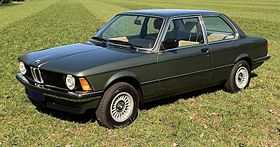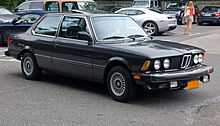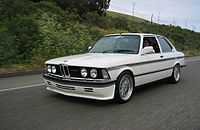BMW 3 Series (E21)
| BMW 3-Series (E21) | |
|---|---|
 | |
| Overview | |
| Manufacturer | BMW |
| Production |
1975–1982 1,364,039 built[1] |
| Assembly | Munich, West Germany |
| Designer | Paul Bracq , Claus Luthe |
| Body and chassis | |
| Class | Entry-level luxury car / Compact executive car |
| Body style |
2-door sedan 2-door convertible |
| Layout | FR layout |
| Powertrain | |
| Engine |
1.6 L M10 I4 1.8 L M10 I4 2.0 L M10 I4 2.0 L M20 I6 2.3 L M20 I6 |
| Transmission |
3-speed automatic 4-speed manual 5-speed manual |
| Dimensions | |
| Wheelbase | 2,563 mm (100.9 in) |
| Length |
4,355 mm (171.5 in) 4,508 mm (177.5 in) (US bumpers) |
| Width | 1,610 mm (63.4 in) |
| Height | 1,380 mm (54.3 in) |
| Chronology | |
| Predecessor | BMW 2002 |
| Successor | BMW E30 |

BMW E21 is the body designation for the first BMW 3 Series compact executive car, produced by the German automaker BMW from 1975 to 1983. This series was the immediate successor to the BMW 2002 and was superseded by the BMW E30.
Development and early history
Under the direction of its 51% percent shareholder, Herbert Quandt, BMW decided upon a replacement for their aging 2002. Without it, there was the distinct possibility of BMW leaving its core mission of building driver oriented cars, and alienating an existing customer base long enamored with the company's 2002 model.
Paul Bracq, Director of Design at BMW from 1970 to 1974, is credited with setting the design direction of the E21 3 Series, while Wilhelm Hofmeister is credited with first drawing the small forward wedge at the base of the C-pillar, a strong design trait of the first Three-series. In 1975 Claus Luthe replaced Bracq and became the owner of the project.
In July 1975, BMW’s Board of Management first presented this new model series in the Munich Olympic Stadium for public appraisal. The frontal view of the new car was dominated by the BMW trademark kidney grille standing out clearly from the radiator cover. The styling of the new car bore a resemblance to the BMW E12 5 Series.
The wedge shape of the two-door model was distinctive, extending all the way to the unusually high rear end. In response to criticism of the tail design, a black plastic trim panel between the tail lights was added. The car's styling was otherwise well received. Measuring 4355 millimeters (171.5 inches) in length, 1610 millimeters (63.4 inches) in width, and 1380 millimeters (54.3 inches) in height, the E21 Series continued the tradition of the New Class. With the wheelbase measuring 2563 millimeters (100.9 in), there was little body overhang in the rear-wheel-drive design. The track measured 1364 millimeters (53.7 in) at the front, and 1377 millimeters (54.2 in) at the rear.
The suspension incorporated rack and pinion steering and MacPherson strut suspension at the front, and semi-trailing arm type independent suspension at the rear. The power assisted brakes were discs on the front wheels, while the rear wheels had drum brakes. Initially, a Getrag four-speed manual was the standard transmission fitment. Five-speed overdrive Getrag gearboxes were fitted as standard in 1980, but close ratio 'sport' gearboxes were available at the car's release as an option. Alternatively, purchasers could opt for the ZF 3 HP-22 three-speed automatic transmission.
The cockpit design of the E21 marked the introduction of a new design concept, with the center console and central dashboard area angled towards the driver. This feature has become part of BMW’s interior design philosophy for many years. As a sign of passive safety, all edges and control elements within the interior were rounded off and padded.
At the E21's release, three models were available: with 316 (1.6-litre), 318 (1.8-litre) and 320 (2.0-litre) versions of the BMW M10 four-cylinder engine. To draw clear visual distinction within the new model series, the 320 models came with dual headlights, while the 315 - 316 and 318 had single round headlights.
At the end of 1975, the 320i was introduced; the engine was fitted with Bosch K Jetronic fuel injection, delivering 125 bhp (93 kW; 127 PS) on premium grade gasoline.
Ongoing evolution
In the mid-1970s, BMW had invested DM 110 million in a new engine series, designated as the M60, but later renamed as M20 upon the introduction of the E30 in late 1982.
At the 1977 International Auto Show in Frankfurt, BMW unveiled its new variants of the E21, featuring the new six-cylinder M20 engines. The four-cylinder 320 model was replaced with the 320/6, featuring a two-litre version of the M20 engine. The 323i model was introduced, featuring 2.3 litres and 143 bhp (107 kW; 145 PS), empowering this car with a top speed of approximately 190 km/h (118 mph). The braking system was also upgraded, with the 323i featuring disc brakes on all wheels.
In the meantime however, a performance gap had developed between the 98 bhp (73 kW; 99 PS) 318 and the new 320/6 delivering 122 bhp (91 kW; 124 PS). For the 1979/80 model year, the four-cylinder models were upgraded: the 1.8-litre power unit was revised and entered the market as a 90 bhp (67 kW; 91 PS) carburetor engine in the 316, while addition of Bosch K Jetronic fuel injection to the 1.8-litre engine raised the 318i to 105 bhp (78 kW; 106 PS) .
Since there was now also room for a new entry-level model, the 315 powered by a 75 bhp (56 kW; 76 PS) 1.6-litre M10 engine made its appearance in 1981.
Motorsports
The Group 5 version of the BMW 320, introduced in 1977 as a replacement to the already obsolete BMW 3.0 CSL and became nicknamed as the Flying Brick in reference to the blocky bodyshape, was powered by a Formula Two engine that was tuned to 300 bhp (220 kW) by BMW Motorsport.
Other than the main factory team and McLaren who ran the IMSA operation in the US, the car was notably used by the BMW Junior Team, who had the likes of Manfred Winkelhock, Eddie Cheever, and Marc Surer as drivers. They would help to win the 1977 Deutsche Rennsport Meisterschaft and would later go into Formula One.
The car was also used to win the Macau Guia Race in 1981 and 1982.
Summary: model range
- 315: The most economical model, introduced to the market in 1981, as a reaction to the second "oil crisis" in late 1979, with a 4-cylinder M10 1.6 L 75 bhp (56 kW; 76 PS) engine and a single downdraft carburetor. More spartan than the other E21 models, it was the last E21 to be built and shared production with the E30.
- 316: The original 3-series base model with M10 1.8 L engine, 90 bhp (67 kW; 91 PS).
- 318: Slightly more powerful version 98 bhp (73 kW; 99 PS) with 1.8 L engine.
- 318i: An upgraded version of the 316 featuring the M10 1.8 L engine fitted with a Bosch K-Jetronic fuel injection system - 105 bhp (78 kW; 106 PS), introduced in 1979 as successor to the carburetted 318.
- 320: Featured an M10 four-cylinder engine with a Solex 2-barrel downdraft carburetor, 109 bhp (81 kW; 111 PS).
- 320i: Upgraded version of 320 with an M10 engine; Bosch K-Jetronic (LambdaO2) fuel injection, 125 bhp (93 kW; 127 PS) and limited slip differential also as an option.
- 320/6: Featured the new BMW 6-cylinder engine, the M20 2.0 L, and a Solex 4-barrel downdraft carburetor; replaced the 320/4 from 1979 on.
- 320is: The 1980 320is for North America offered Recaro seats, a rear antiroll bar, a limited-slip differential, cross-spoke wheels, a larger-diameter front antiroll bar, a 3-spoke leather-wrapped steering wheel, and a special front air dam.
- 323i: Featuring the M20 and Bosch K Jetronic fuel injection, the 323i was the top model of the line with 143 bhp (107 kW; 145 PS) and four-disc power-assisted brakes. Options include power steering, a 5-speed close-ratio 'dogleg' sport gearbox, and 25% limited slip differential.
Variants

_-_(1).jpg)


USA market variants featured different headlights to the European and other export versions. The 320i was available in the United States market and was remarkably different from the European models. Department of Transportation (DOT) safety regulations required larger bumpers, different headlight sets, and DOT marker lamps on the sides. Adapting the engines to meet US exhaust emissions regulations resulted in a smaller engine in the 320i (downgraded to 1.8 L) and less horsepower output compared to the European market versions.
A cabriolet conversion was offered by Karosserie Baur GmbH, based on regular E21 models. The cabriolet conversion was composed of a targa roof and an independent rear soft-top. Production of the Baur TopCabriolet began in 1978, and were sold via the BMW dealership network. All TopCabriolets included the BMW warranty. A total of 4,595 vehicles were manufactured before production ended in 1981.
Before BMW had their “M" cars, a cadre of small European performance companies such as Hartge, Alpina and AC Schnitzer modified and tuned cars from BMW offering aftermarket modifications. Cars modified by European performance companies like Hartge and Alpina could be faster and looked different. They were accessible through a few small companies who chose to navigate the safety regulations and emission rules of the U.S. Department of Transportation.
Hartge
Brothers Herbert and Rolf Hartge started modifying BMWs in small numbers in Merzig, Germany around 1971. Herbert Hartge had been involved with cars since his youth and, from 1969 to 1983, was a successful racing driver with Formula V racing and touring cars, primarily BMWs. In the late 1970s to early 1980s, Hartge made available two E21 models: the Hartge H3 323i and the H3S 335i.
The first E21 was the Hartge H3 323i: many of these were built for a customer’s specific application using modified parts Hartge offered in their sales brochures and catalogs. Build options included bodywork, a modified 2.3L 180 hp (134 kW), choice in 5-speed transmissions: the "economic" which was the standard H pattern 5-speed with first gear up and the fifth up; and the “dogleg sport” with its first gear over and down. Hartge offered a choice of gear ratios in the rear differential to enhance performance on the open road, mountain driving, to the race track.
The second E21 model was the monster Hartge H3S 335i. For this Hartge modified a 6-cylinder 3.5 L transplanted out of a BMW 635CSi. This produced 205 hp (153 kW) which was a reduction in power compared to 218 CVs of E23 and E24 made necessary in order to meet anti-pollution laws in force, which set limits to emissions of CO in relation to power-to-weight ratio. Since the 3500 cc engine coupled to the body of the E21 Series 3 was smaller and lighter than the 6 Series and 7, it exceeded these limits and was necessary to cut 13 hp (10 kW) in order to obtain approval. In 1982, thanks to head, valves, camshaft and exhaust manifolds, specific power reached a peak of 240 hp (179 kW) for a maximum speed of 240 km/h (149 mph) and launched it from 0–100 km in 6 seconds. The H3S had two options for the transmission, both manual 5-speeds. The first was out of a BMW 735 with a conventional first gear up shift pattern and relationships between gears longer. The second was a derivation of the 635CSi’s dogleg sport with its first gear down pattern and short shift between gears for faster acceleration.
Both models were offered ample opportunities for customization with various accessories, including additional instrumentation, front and rear seats, leather, fabric, or special alzacristalli upholstery, electric mirrors, Hartge decals and emblems, suspension, exhaust, engine, wheels, brakes, and other options available in the Hartge catalogs. Although BMW ended production of the E21 model in 1982, Hartge continued to offer parts in their brochures for the E21 through the 1989 model catalog.
Alpina
Alpina offered the B6 2.8. Introduced at the IAA in 1978, it was produced from March 1978 until January 1983. Only 533 units were built. The B6 2.8 transplanted the 2.8 L M30 engine from the 528i model into the 323i. Alpina fitted forged Mahle pistons, modified the combustion chambers, and used a Zenith-Pierburg-DL fuel injection system. These modifications raised engine output from 177 bhp (132 kW; 179 PS) to approximately 200 bhp (149 kW; 203 PS).
References
Further reading
- Jeremy Walton (2001). BMW 3-Series Collectors Guide: Generation 1 and 2 including M3. Motor Racing Publications. ISBN 1-899870-55-5.
- R.M. Clarke (1990). BMW Series 3 - 4 Cylinder Cars Gold Portfolio. Brooklands Books. ISBN 1-85520-149-6.
External links
| Wikimedia Commons has media related to BMW E21. |
| « previous — BMW road car timeline, 1950s–1980s — next » | |||||||||||||||||||||||||||||||||||||||||
|---|---|---|---|---|---|---|---|---|---|---|---|---|---|---|---|---|---|---|---|---|---|---|---|---|---|---|---|---|---|---|---|---|---|---|---|---|---|---|---|---|---|
| Type | Series | 1950s | 1960s | 1970s | 1980s | ||||||||||||||||||||||||||||||||||||
| 0 | 1 | 2 | 3 | 4 | 5 | 6 | 7 | 8 | 9 | 0 | 1 | 2 | 3 | 4 | 5 | 6 | 7 | 8 | 9 | 0 | 1 | 2 | 3 | 4 | 5 | 6 | 7 | 8 | 9 | 0 | 1 | 2 | 3 | 4 | 5 | 6 | 7 | 8 | 9 | ||
| Microcar | Isetta 250/300 | ||||||||||||||||||||||||||||||||||||||||
| Small family car | 600 | LS/700 | |||||||||||||||||||||||||||||||||||||||
| Compact exec | 3 Series | 1602/2002 | E21 | E30 | |||||||||||||||||||||||||||||||||||||
| Executive | 5 Series | 340/340-2* | 1500,1800,2000 | E12 | E28 | E34 | |||||||||||||||||||||||||||||||||||
| Luxury | 7 Series | 501/502 | E3 | E23 | E32 | ||||||||||||||||||||||||||||||||||||
| Coupé | 1600GT | ||||||||||||||||||||||||||||||||||||||||
| 6 Series | 327* | 503 | 3200 CS | 2000C, 2000CS | E9 | E24 | |||||||||||||||||||||||||||||||||||
| Roadster | Z Series | 507 | Z1 | ||||||||||||||||||||||||||||||||||||||
| Sports car/GT | M1, 8 Series | E26 | E31 | ||||||||||||||||||||||||||||||||||||||
| *made in East Germany as EMW | |||||||||||||||||||||||||||||||||||||||||
| « previous — BMW road car timeline, 1980s–present | ||||||||||||||||||||||||||||||||||||||
|---|---|---|---|---|---|---|---|---|---|---|---|---|---|---|---|---|---|---|---|---|---|---|---|---|---|---|---|---|---|---|---|---|---|---|---|---|---|---|
| Type | Series | 1980s | 1990s | 2000s | 2010s | |||||||||||||||||||||||||||||||||
| 0 | 1 | 2 | 3 | 4 | 5 | 6 | 7 | 8 | 9 | 0 | 1 | 2 | 3 | 4 | 5 | 6 | 7 | 8 | 9 | 0 | 1 | 2 | 3 | 4 | 5 | 6 | 7 | 8 | 9 | 0 | 1 | 2 | 3 | 4 | 5 | 6 | ||
| Compact | 1 Series | E82 / E88 | ||||||||||||||||||||||||||||||||||||
| E81 / E87 | F20 / F21 | |||||||||||||||||||||||||||||||||||||
| 2 Series | F22 / F23 | |||||||||||||||||||||||||||||||||||||
| F45 | ||||||||||||||||||||||||||||||||||||||
| 3 Compact | E36/5 | E46/5 | ||||||||||||||||||||||||||||||||||||
| Compact executive | 3 Series | E21 | E30 | E36 | E46 | E90 / E91 / E92 / E93 | F30 / F31 / F35 | |||||||||||||||||||||||||||||||
| 4 Series | F32 / F33 / F36 | |||||||||||||||||||||||||||||||||||||
| Executive | 5 Series | E12 | E28 | E34 | E39 | E60 / E61 | F10 / F11 | |||||||||||||||||||||||||||||||
| Luxury | 6 Series | E24 | E63 / E64 | F06 / F12 / F13 | ||||||||||||||||||||||||||||||||||
| 7 Series | E23 | E32 | E38 | E65 / E66 / E67 / E68 | F01 / F02 / F03 / F04 | |||||||||||||||||||||||||||||||||
| GT | 8 Series | E31 | ||||||||||||||||||||||||||||||||||||
| Roadster | Z Series | E30 (Z1) | E36/7 & E36/8 (Z3) | E85 / E86 (Z4) | E89 (Z4) | |||||||||||||||||||||||||||||||||
| M | 1 Series M | E82 M | ||||||||||||||||||||||||||||||||||||
| M3 | E30 M3 | E36 M3 | E46 M3 | E90/92/93 M3 | F80 | |||||||||||||||||||||||||||||||||
| M4 | F82 / F83 | |||||||||||||||||||||||||||||||||||||
| M5 | E28 M5 | E34 M5 | E39 M5 | E60/61 M5 | F10 M5 | |||||||||||||||||||||||||||||||||
| M6 | E24 M635CSi/M6 | E63/64 M6 | F06/12/13 M6 | |||||||||||||||||||||||||||||||||||
| M Roadster | E36/7 (Z3) M | E85 (Z4) M | ||||||||||||||||||||||||||||||||||||
| M Coupé | E36/8 M Coupé | E86 M Coupé | ||||||||||||||||||||||||||||||||||||
| Sports car | E26 (M1) | E52 (Z8) | ||||||||||||||||||||||||||||||||||||
| SAV | X1 | E84 | ||||||||||||||||||||||||||||||||||||
| X3 | E83 | F25 | ||||||||||||||||||||||||||||||||||||
| X4 | F26 | |||||||||||||||||||||||||||||||||||||
| X5 | E53 | E70 | F15 | |||||||||||||||||||||||||||||||||||
| X6 | E71 / E72 | F16 | ||||||||||||||||||||||||||||||||||||
| PAV | 3 GT | F34 | ||||||||||||||||||||||||||||||||||||
| 5 GT | F07 | |||||||||||||||||||||||||||||||||||||
| i | i3 | I01 | ||||||||||||||||||||||||||||||||||||
| i8 | I12 | |||||||||||||||||||||||||||||||||||||